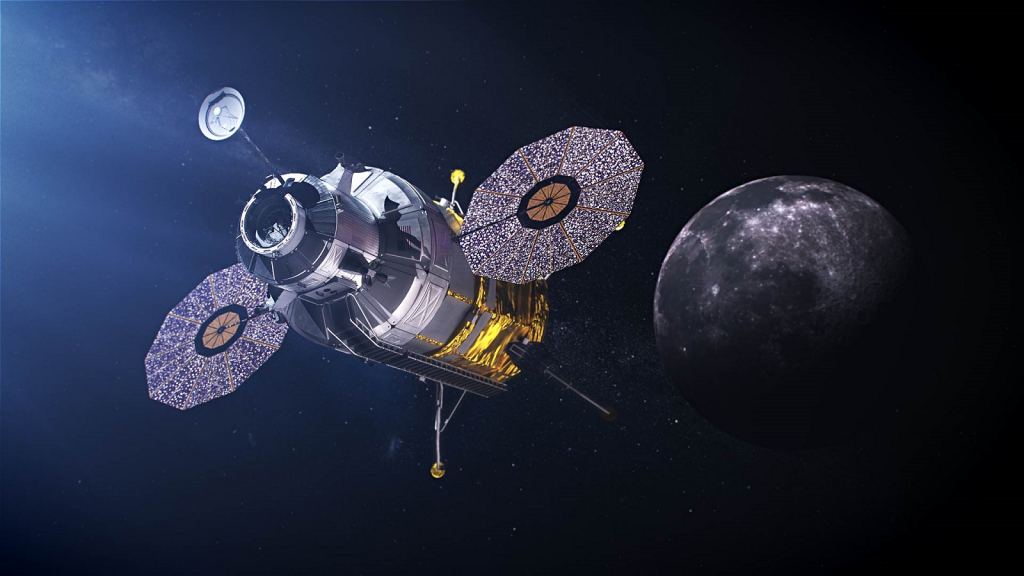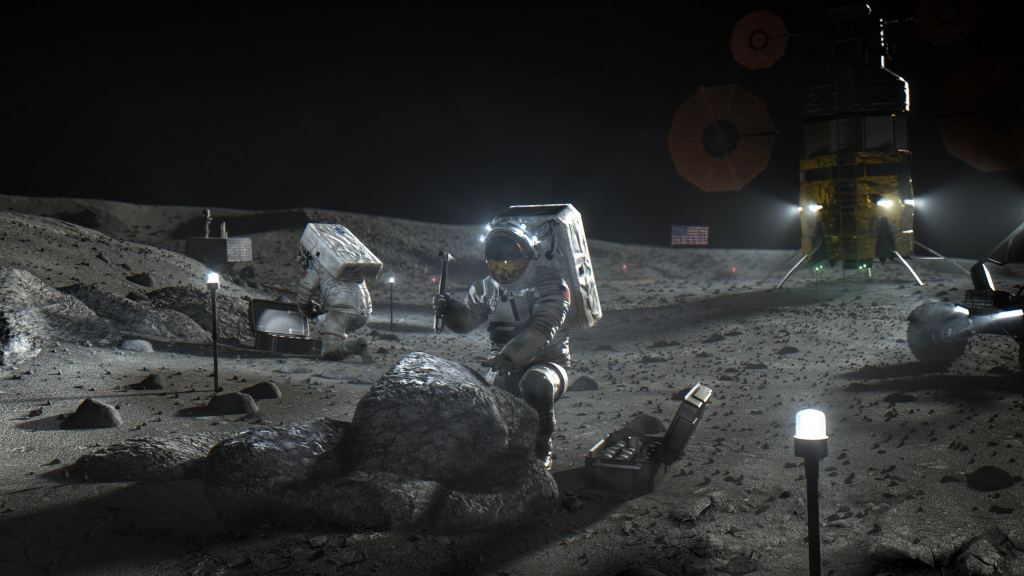Project Artemis, NASA's long-awaited plan for sending astronauts to the Moon for the first time since the Apollo Era, has taken many steps forward. Aside from the development of the Space Launch System (SLS), the *Orion spacecraft*, and the elements that will make up the Lunar Gateway, NASA recently awarded SpaceX with the contract to build the Human Landing System (HLS) that will transport astronauts to the lunar surface.
However, this decision didn't sit well with the other two companies NASA was also considering. These included Blue Origin, the commercial space company founded by Amazon founder and former CEO Jeff Bezos, and Alabama-based aerospace company Dynetics. After protests were filed by both companies, NASA decided to issue a stop-work order on the HLS award to SpaceX while it reviews the complaints.
As part of the Next Space Technologies for Exploration Partnerships (NextSTEP-2), NASA announced the selection of these three companies to develop HLS concepts back in April of 2020. The three companies were issued fixed-price contracts with a combined value of $967 million for a 10-month base period, during which time, NASA experts worked with each to help bring their concepts to fruition.
For their part, SpaceX offered their design for a fully integrated vehicle that bears a strong resemblance to the Starship, though modified to accommodate lunar landings. Blue Origin, meanwhile, produced a design for a three-stage lunar lander co-developed with Northrop Grumman and Lockheed Martin. Known as the Integrated Lander Vehicle (ILV), this spacecraft would consist of a descent, transfer, and ascent element.
Then there was the Dynetics Human Landing System (DHLS), a single-stage vehicle that can provide both descent and ascent capabilities and sits low to the ground to accommodate quick access to the surface and allows for tools and samples to be quickly stowed. As of April 16th, 2021, NASA announced that it had decided to go with SpaceX's concept for a modified-Starship, which included a firm and fixed-price contract worth $2.9 billion.
On April 26th, Blue Origin contested the decision, filing a 50-page statement with the federal Government Accountability Office (GAO). Bob Smith (chief executive of Blue Origin) was interviewed by the New York Times shortly thereafter. In the course of talking to Kenneth Chang, Smith claimed that a flawed evaluation was the reason why the company was passed over in favor of SpaceX.
In particular, he felt NASA was downplaying the risks associated with SpaceX's design, underestimating the advantages of Blue Origin's, and focused too much on bottom-line costs:
"It’s really atypical for NASA to make these kinds of errors. They’re generally quite good at acquisition, especially its flagship missions like returning America to the surface of the moon. We felt that these errors needed to be addressed and remedied."
Loading tweet...
— View on Twitter
Musk, in a characteristic display of cheekiness bordering on bad taste, took to Twitter to respond to the news. "Can't get it up (to orbit) lol," he tweeted, referencing the fact that Blue Origin has yet to reach orbit with any of its rockets. This includes their New Shepard* launch vehicle and their two-stage New Glenn* rocket, both of which have been stuck in development limbo for years.
On April 30th, Dynetics followed with a 61-page statement of their own, which was issued by the company's law firm (Friend, Frank, Harris, Shriver & Jacobson LLP) and co-signed by Blue Origin. A copy of the statement was obtained by Space News, which emphasized that NASA had initially planned to award "Option A" contracts to two companies for the sake of realizing "the benefits of competition when making down-selections."
By selecting SpaceX alone for an Option A contract, they claim, that NASA had effectively abandoned the ground rules it had previously established for the program:
"In selecting SpaceX as the only Option A contractor in this second phase for the HLS program (and, consequently, for the last phase, as well), NASA has prematurely abandoned a core element of the acquisition strategy behind the HLS program -- i.e., 'to create the most competitive environment practicable, maximizing the likelihood of successful development that will culminate in crewed demonstration missions.'"
This is in reference to what NASA indicated in their Source Selection Statement, which accompanied the April 16th announcement that they were awarding the HLS contract to SpaceX. Early on in the document, the Source Selection Authority (SSA) indicates why NASA was forced to go with one Option A award instead of two:
"While it remains the Agency’s desire to preserve a competitive environment at this stage of the HLS Program, at the initial prices and milestone payment phasing proposed by each of the Option A offerors, NASA’s current fiscal year budget did not support even a single Option A award. "Working in close coordination with the [Contracting Officer] CO, it was therefore my determination that NASA should, as a first step, open price negotiations with the Option A offeror that is both very highly rated from a technical and management perspective and that also had, by a wide margin, the lowest initially-proposed price—SpaceX."
Acknowledging the role budget constraints and scheduling changes played, Dynetics legal representatives go on to state that NASA acted in bad faith by failing to explore the other options that were available to them. Ultimately, these boil down to consulting the potential contractors and letting them know that the situation had changed since the Appendix H, NextSTEP-2 solicitation was made.
Or as they put it, NASA could have "i) amended the Solicitation to reflect its new acquisition strategy and budget; (ii) opened discussions with the offerors to advise them of NASA's new strategy and to allow the offerors to submit revised proposals; or (iii) withdrawn or canceled the Solicitation given its incompatibility with the severe budget constraints imposed on the HLS program."
Dynetics also echoed Blue Origin's sentiments about the technical risks arising from SpaceX's design and approach. These risks, they claim, have been made evident by the company's recent flight tests with their Starship prototypes, all four of which have resulted in explosions during landing (or shortly thereafter):
"SpaceX’s approach presented high and unacceptable risk to successful contract performance, and not the watered-down “weakness” identified by NASA.Indeed, the Source Selection Statement is devoid of any mention let alone consideration of the inherent risks associated with the fact that four SpaceX Starship prototypes have exploded in the last four months alone. " Landing people on the Moon requires a great deal of space systems engineering, in order to identify and reduce the inherent and considerable risks of human spaceflight, and NASA has given SpaceX a pass on its demonstrable lack of such systems engineering."
In response, NASA spokesperson Monica Witt issued a statement on Friday, April 30th. "Pursuant to the GAO protests," she said. "NASA instructed SpaceX that progress on the HLS (human landing system) contract has been suspended until GAO resolves all outstanding litigation related to this procurement."
Arguably, some of what was said in the Dynetics statement was a little below the belt. Using the fact that four Starship prototypes blew up when they tried to stick the landing, and for the purpose of trying to keep SpaceX from getting an HLS contract? That's just plain mean! Then again, Musk did make a thinly-veiled impotence joke about Bezos, so no one's hands are entirely clean here.
And it is possible a case can be made for NASA not doing its due diligence in keeping everyone informed of its changing situation. Of course, that's a far cry from getting the GAO to order a second Option A contract to either Dynetics or Blue Origin. But whether NASA failed to act properly and whether the complainants have grounds for a challenge is a matter for the courts.
In meantime, the impact that this will have on the development of the HLS or the Artemis Program remains to be seen.
*Further Reading: Space News*
 Universe Today
Universe Today



